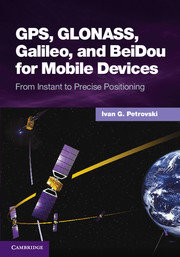Book contents
- Frontmatter
- Contents
- Foreword by Glen Gibbons
- About this book
- Acknowledgments
- List of abbreviations and acronyms
- List of definitions
- Part I GNSS: orbits, signals, and methods
- Part II From conventional to software GNSS receivers and back
- 5 Generic GNSS receivers
- 6 Receiver implementation on a general processor
- 7 Common approach and common components
- Part III Mobile positioning at present and in the future
- Part IV Testing mobile devices
- Index
- References
7 - Common approach and common components
from Part II - From conventional to software GNSS receivers and back
Published online by Cambridge University Press: 05 May 2014
- Frontmatter
- Contents
- Foreword by Glen Gibbons
- About this book
- Acknowledgments
- List of abbreviations and acronyms
- List of definitions
- Part I GNSS: orbits, signals, and methods
- Part II From conventional to software GNSS receivers and back
- 5 Generic GNSS receivers
- 6 Receiver implementation on a general processor
- 7 Common approach and common components
- Part III Mobile positioning at present and in the future
- Part IV Testing mobile devices
- Index
- References
Summary
Common approach for receiver design
In Chapter 6 we discussed a “software approach” to GNSS receivers in comparison with a traditional “conventional” approach. In this chapter we consider a common approach taken in the implementation of a receiver, or more precisely in the implementation of a baseband processor. The “common components” refers then to the realization of those components, that are independent of the “conventional” or “software” approach. For example, a realization of an RF front end does not depend on whether a receiver is implemented with either a “conventional” or “software” approach in mind. The same is true for a navigation processor, as its implementation is always via software.
The difference between the “conventional” and the “software” approaches is that in the latter case the baseband processor is implemented in software on a general processor. This led to a definition of the “GPS software receiver,” which is a more narrow definition than software-defined radio (SDR). We discuss the details in Chapter 10, Section 10.3. The software approach [1] effectively allowed researchers in the GPS field to look at the receiver from a different perspective. It was essential in order to change the approach to receiver development. It has also introduced a set of new (for this area) instruments, in particular fast Fourier transform.
- Type
- Chapter
- Information
- GPS, GLONASS, Galileo, and BeiDou for Mobile DevicesFrom Instant to Precise Positioning, pp. 190 - 204Publisher: Cambridge University PressPrint publication year: 2014



